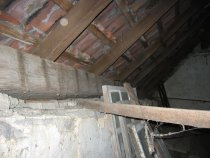Photo Record
Images

Metadata
Collection |
DeTurk |
Title |
Attic granary interior |
Archive Number |
DTR09PH103 |
Description |
Southeast portion of DeTurk House attic granary showing east eaves wall plate [large hewn beam extending into the corner starting at the left edge of the photo]. This plate is rotated several degrees from the horizontal and curves outward, either from roof thrust or possibly because of a prior structural function, probably in another building{1}. Although insufficient "curing" [drying through evaporation] is possible as a contributory cause of the curvature, it is quite unlikely that the original builders would have installed a "green" timber for the important function of a wall plate deployed to carry the substantial loads of a roof and its timber support structure. The roof rafters and lath were installed in the 1970s. The early clay tiles were assembled from several sources, including a group found in this 1767 building (see DTHTX18--1001.01.017 manuscript sheet headed ‘[DeTurk] Restoration Plans’ paragraph 2, which states "Enough tiles are available for the roof: 1000? Stored in DeTurk House, 1st floor, 700? Stored at Jack Keller’s farm…600? stored at Dr. German’s house (donated by Paul Blatt, Bernville)." The iron tie rod on the right (shown more fully in the left half of photo DTR09PH102--1001.01.198) was installed in the 20th century to restrain roof thrust. This retrofit was necessitated by the inadequate integration ["tying"] of the wall plates into the structure in the original building campaign. This problem was compounded by the inability to install continuous tie beams from eaves-corner to eaves-corner because of the chimney in the north gable wall and the granary door in the south gable wall. A secondary possible cause of the partial failure of the roof support system was the replacement of lighter roof covering, wooden shingles, with heavier slate and clay tiles during various re-roofing projects on the building. This would impose substantially greater lateral thrust on the rafter plates and the masonry stone courses supporting them, tension on the rafters and their support members. FOOTNOTE {1} The darker vertical bands, possibly from joists bearing on this timber and reducing oxidation from exposure to air, on the inner [west] face of the rafter plate{n} might indicate prior use as a summer beam. The outward curve [which would project downward if the plate were rotated to set the bands facing upward under joists], would probably be caused by deflection of the beam from many years of load-bearing in functioning as a "summer" or girder. {n}so called because of its primary function as the "wall" plate [generically, any timber borne on, or embedded in, a masonry wall] supporting the roof rafters and the loads they bear. Laurence Ward, 2009, updated March 2021 |
Search Terms |
DTR09PH DTHPH DTR09 DT De Turck De Turk DeTurck DeTurk DeTurk House Tie Rod Wall Plate Rafter Rafter Plate Summer beam |
People |
DeTurk, John |
Object Name |
Print, Photographic |
Accession number |
1001.01 |
Date |
10/12/2009 |
Photographer |
Larry Ward |
Catalog Number |
1001.01.199 |

